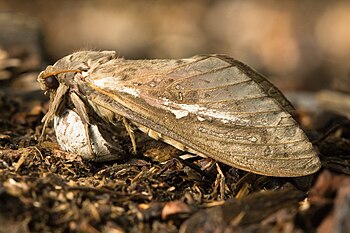Talk:Abantiades latipennis
| Abantiades latipennis has been listed as one of the Natural sciences good articles under the good article criteria. If you can improve it further, please do so. If it no longer meets these criteria, you can reassess it. | ||||||||||
| ||||||||||
A fact from this article appeared on Wikipedia's Main Page in the "Did you know?" column on June 10, 2009. The text of the entry was: Did you know ... that the Australian moth Abantiades latipennis (pictured) is well-adapted to surviving clearfelling and thrives in regrowth forests? | ||||||||||
| This article is rated GA-class on Wikipedia's content assessment scale. It is of interest to the following WikiProjects: | ||||||||||||||||||||||||||||||||||||||||
| ||||||||||||||||||||||||||||||||||||||||
File:Abantiades latipennis.jpg to appear as POTD soon
[edit]Hello! This is a note to let the editors of this article know that File:Abantiades latipennis.jpg will be appearing as picture of the day on November 23, 2010. You can view and edit the POTD blurb at Template:POTD/2010-11-23. If this article needs any attention or maintenance, it would be preferable if that could be done before its appearance on the Main Page so Wikipedia doesn't look bad. :) Thanks! howcheng {chat} 19:24, 22 November 2010 (UTC)
External links modified
[edit]Hello fellow Wikipedians,
I have just modified 2 external links on Abantiades latipennis. Please take a moment to review my edit. If you have any questions, or need the bot to ignore the links, or the page altogether, please visit this simple FaQ for additional information. I made the following changes:
- Added archive https://web.archive.org/web/20100516133301/http://landcareresearch.co.nz/research/biosystematics/invertebrates/faunaofnz/Extracts/FNZ30/fnz30pop.asp to http://www.landcareresearch.co.nz/research/biosystematics/invertebrates/faunaofnz/Extracts/FNZ30/fnz30pop.asp
- Added archive https://web.archive.org/web/20090924075553/http://www-staff.it.uts.edu.au/~don/larvae/hepi/latipen.html to http://www-staff.it.uts.edu.au/~don/larvae/hepi/latipen.html
- Added
{{dead link}}tag to http://www.samuseum.sa.gov.au/Journals/RSAM/RSAM_v004/rsam_v004_p497p536.pdf
When you have finished reviewing my changes, you may follow the instructions on the template below to fix any issues with the URLs.
This message was posted before February 2018. After February 2018, "External links modified" talk page sections are no longer generated or monitored by InternetArchiveBot. No special action is required regarding these talk page notices, other than regular verification using the archive tool instructions below. Editors have permission to delete these "External links modified" talk page sections if they want to de-clutter talk pages, but see the RfC before doing mass systematic removals. This message is updated dynamically through the template {{source check}} (last update: 5 June 2024).
- If you have discovered URLs which were erroneously considered dead by the bot, you can report them with this tool.
- If you found an error with any archives or the URLs themselves, you can fix them with this tool.
Cheers.—InternetArchiveBot (Report bug) 23:17, 24 June 2017 (UTC)
Life Cycle and Behavior Section
[edit]Hello, I am a student at Washington University in St. Louis interested in writing and learning about moths and butterflies. Thank you for the informative article. A possible comment I have is that the Life cycle and behavior section of the article could actually be split into 3 different sections, each with more researched and rich information: Life cycle, Key behaviors, and Mating. In addition, the Life cycle section of the article should include images that allow easy visualization of the stages of development from caterpillar to moth. Additionally, I believe that a mating strategy or mating section should be added. The mating behaviors of Abantiades latipennis are discussed within the Life cycle and behavior subsection, but only a few sentences are devoted to discussing this topic. As mating and reproduction are an important aspect of the behavioral ecology of the moth, I would create a separate subsection for this and research it more thoroughly, perhaps providing images to illustrate here as well. Thanks again for this article--it piqued my curiosity! S.srivatsa (talk) 02:55, 14 September 2017 (UTC)
- Wikipedia good articles
- Natural sciences good articles
- Wikipedia Did you know articles that are good articles
- GA-Class Insects articles
- Low-importance Insects articles
- WikiProject Insects articles
- GA-Class Lepidoptera articles
- Low-importance Lepidoptera articles
- WikiProject Lepidoptera articles
- GA-Class Australia articles
- Low-importance Australia articles
- GA-Class Australian biota articles
- Low-importance Australian biota articles
- WikiProject Australian biota articles
- WikiProject Australia articles






